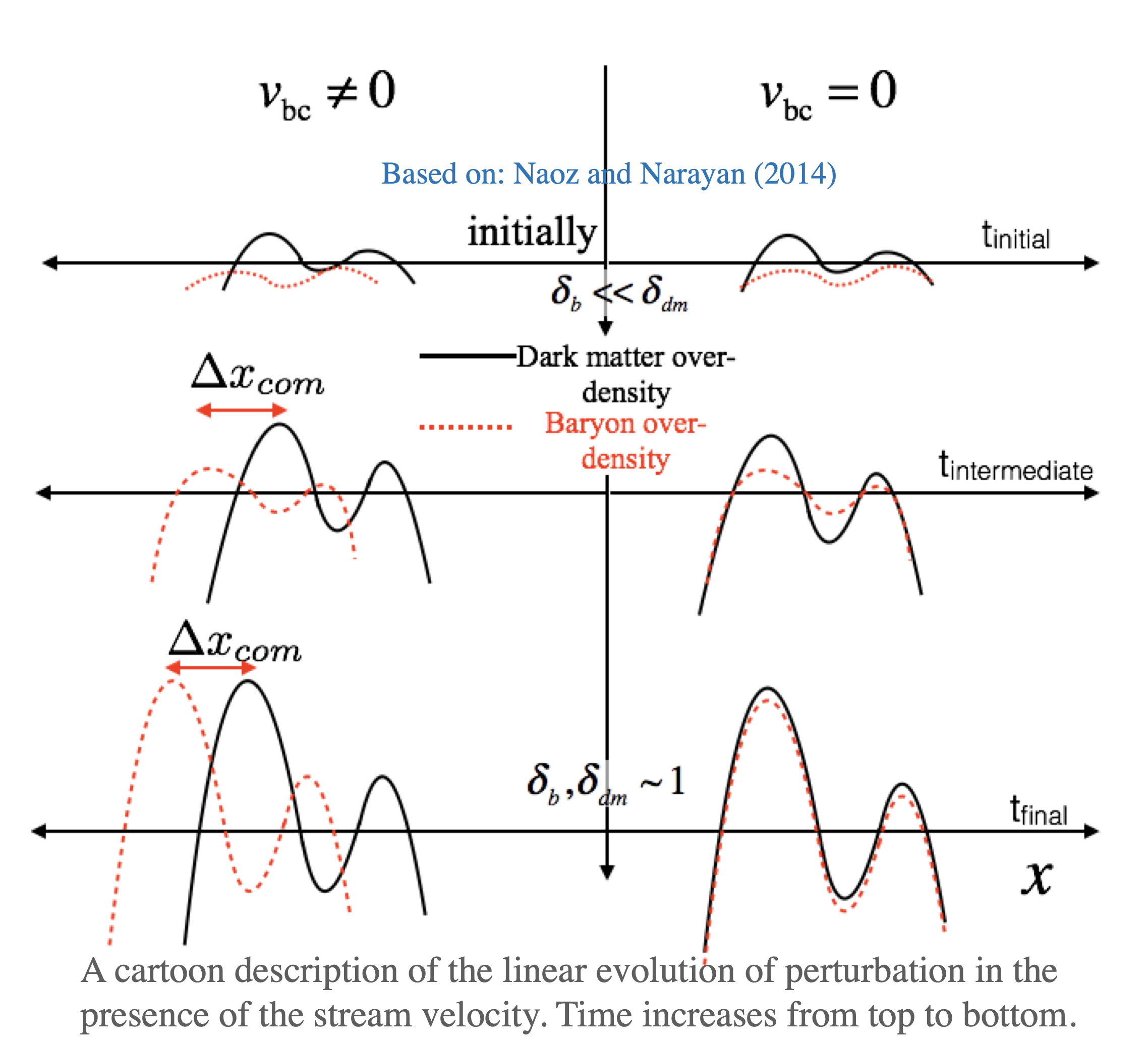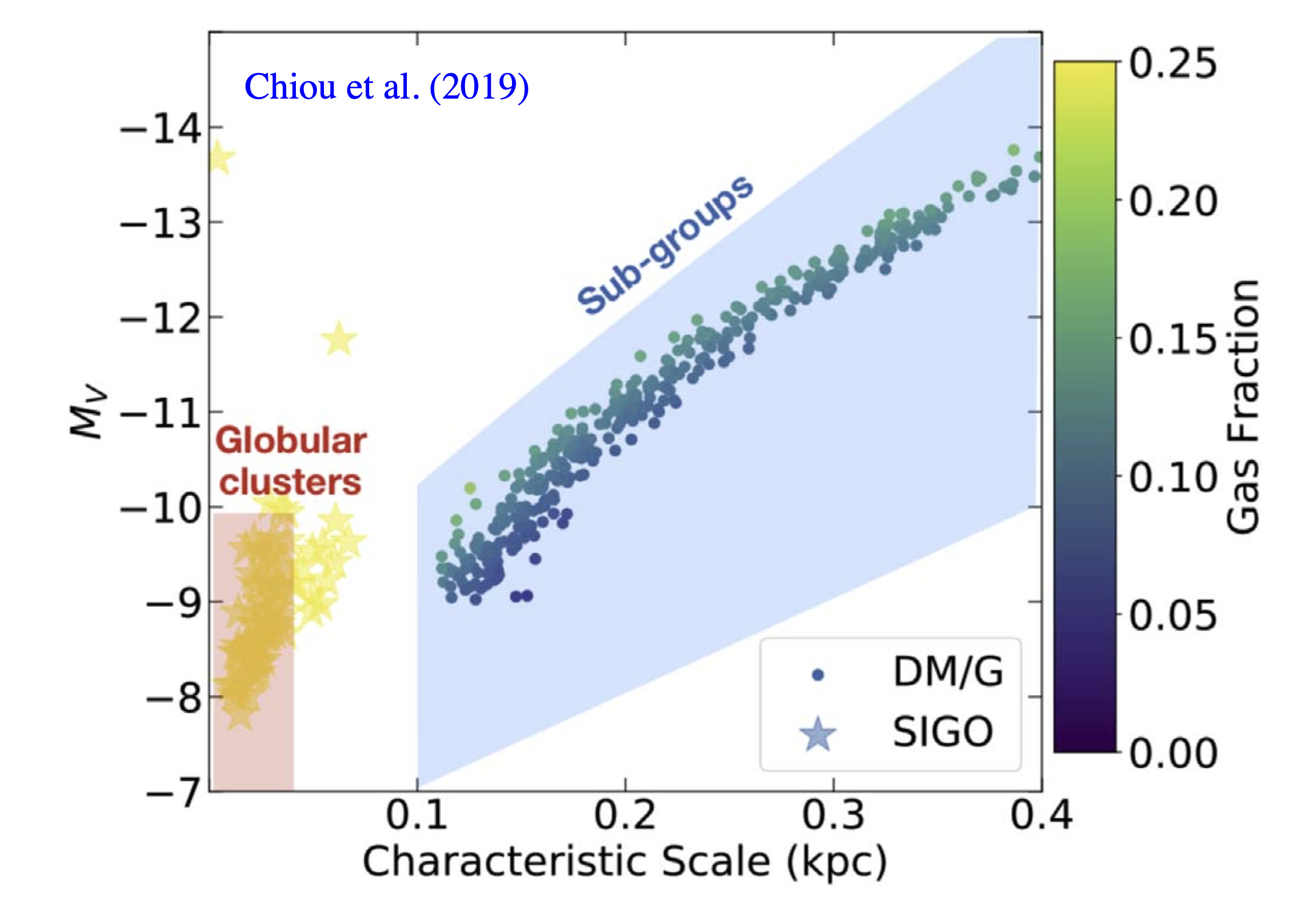Astrophysics Research
PhD Thesis: The Supersonic Project: Supersonically Induced Gas Objects in the Early Universe

A new formation channel for globular clusters
A globular cluster (GC) is a stable tightly bound group of stars that orbits a galaxy’s core. They are some of the oldest bound objects in the Universe. They have even been used to measure the age of the Universe (Krauss and Chaboyer, 2003). Observations indicate that GC contain practically no gravitationally bound DM (e.g., Bradford et al., 2011; Conroy et al., 2011; Heggie and Hut, 1996; Ibata et al., 2013) Despite decades of investigation, their cosmic origins remain debated. Two of the most popular scenarios are described as follows. Gunn (1980) proposed that GCs are formed in strong shocks when gas is compressed during galaxy mergers. Many massive young star clusters in the Antennae system have been found (e.g., Whitmore and Schweizer, 1995; Whitmore et al., 1999), giving support to this idea. This formation scenario has also been included in cosmology hierarchical structure formation models (e.g., Ashman and Zepf, 1992; Harris and Pudritz, 1994; Kravtsov and Gnedin, 2005; Muratov and Gnedin, 2010). However, observations of nuclear star clusters (e.g, Böker et al., 2004; Brown et al., 2014; Walcher et al., 2006, 2005) imply that GC-like structure can form inside DM halos and reside in their centers, in direct contrast to this theory. The other popular scenario proposed by (Peebles, 1984) is that like all structure, GCs formed inside DM halos which were later stripped by the tidal field of their host galaxies, leaving the central parts deficient of dark matter (e.g., Bekki and Yong, 2012; Bromm and Clarke, 2002; Mashchenko and Sills, 2005; Saitoh et al., 2006). However, some GCs are observed to have stellar tidal tails, which is difficult to understand if the objects have extended DM halos (Grillmair et al., 1995; Mashchenko and Sills, 2005; Moore, 1996; Odenkirchen et al., 2003). Here I provide an alternative formation scenario through the stream velocity.
Stream Velocity
In the standard model of structure formation, due to the baryon-radiation coupling, baryon over-densities at the time of recombination were about five orders of magnitude smaller than dark matter over-densities. Tseliakhovich and Hirata (2010) showed that not only the amplitudes of the dark matter and baryonic density fluctuations were different at early times, but so were their velocities. After recombination, the baryons decoupled from the photons, and their subsequent evolution was dominated by the gravitational potential of the dark matter. In the period following recombination, the baryons underwent rapid cooling. At this point, their relative velocity with respect to dark matter, which at recombination was on the order of ∼ 30 km / sec, was, in fact, supersonic. Tseliakhovich and Hirata (2010) also showed that this relative velocity between the baryons and the dark matter remained coherent on scales of a few megaparsecs, and in these regions, it can be modeled as a stream velocity.
Although formally a second-order effect, the stream velocity has far-reaching consequences on a wide variety of cosmological phenomena. In particular, the non-linear effects of the stream velocity on the first structures were subsequently investigated using numerical simulations, as well as analytically, and it was shown that the stream velocity tends to suppress the formation of gas-rich small-scale structures at the early Universe. Additionally, this relative velocity may have nontrivial effects on the cosmological 21 cm signal, the formation of primordial black holes, and even on primordial magnetic fields.
Supersonically Induced Gas Objects (SIGOs)
Supersonically-induced gas objects (SIGOs) with little to no dark matter (DM) component are predicted to exist in patches of the universe with a non-negligible relative velocity between baryons and the DM at the time of recombination (see Naoz and Narayan (2014) ). Using AREPO hydrodynamic simulations, we find that the gas densities inside of these objects are high enough to allow stars to form. SIGOs may be linked with present-day metal-poor local globular clusters. In the figure at the top of the page, we see example for SIGO (projected) with its environment (adopted from Chiou et al 2021.)
 The stream velocity introduces a phase shift between the baryons and the dark matter (see cartoon). This phase shift translates into a physical separation between the dark matter and baryon over-densities. In Naoz and Narayan (2014) we used linear analysis to calculate the phase difference between the baryons and dark matter. In this work, using the framework of linear analysis, we showed that these baryons might have become non-linear and formed baryon-dominated bound objects that are physically separated from their parent dark matter halos. We coin these structures “supersonically-induced gas objects” (SIGOs). For an interesting range of masses, we found that the spatial offset is larger than the virial radius of the dark matter halo, allowing the baryonic clumps to survive as independent dark matter-free objects.
The stream velocity introduces a phase shift between the baryons and the dark matter (see cartoon). This phase shift translates into a physical separation between the dark matter and baryon over-densities. In Naoz and Narayan (2014) we used linear analysis to calculate the phase difference between the baryons and dark matter. In this work, using the framework of linear analysis, we showed that these baryons might have become non-linear and formed baryon-dominated bound objects that are physically separated from their parent dark matter halos. We coin these structures “supersonically-induced gas objects” (SIGOs). For an interesting range of masses, we found that the spatial offset is larger than the virial radius of the dark matter halo, allowing the baryonic clumps to survive as independent dark matter-free objects.
Significantly, Chiou et al. (2019), using numerical simulations, combined with semi-analytical modeling, we showed that the present-day, local, absolute visual magnitude and the SIGOs characteristic scale is consistent with the observed globular cluster population, see Figure. This hints at a possible identification of the SIGOs as the progenitors of present day, low metalicity, globular clusters.
 In the Figure above, from Chiou et al. (2019), we speculated on how SIGOs and DM/G objects will be observed today. Assuming a burst-like star formation before reionization (z=10), we adopted an initial mass function (IMF) for the objects. In particular, we followed Decressin et al. (2007), and a Salpeter IMF for the DM/G. We calculated the fraction of spectral types of stars that evolve along the main sequence. The majority of the stars that survive to the present day will be G and K type stars, as well as red giants. Given this population, we subtracted their various bolometric corrections. We then roughly estimated each object’s visual bolometric magnitude. We also estimated that the observed stellar cluster that formed within the SIGOs corresponds to the highest density peak. We also over-plotted the region of the parameter space that is associated with GCs (red box) and Andromeda and the Milky Way sub-groups (blue area; McConnachie 2012). Heuristically, the SIGOs are consistent with the absolute visual magnitudes of present-day, local GCs. Although the SIGOS in this simulation only contain primordial gas, we speculated that some self-enrichment or second population-formation mechanism (such as pericenter passage of orbits about the nearest DM halo) may contribute to the nonzero metallicity in metal-poor GCs.
In the Figure above, from Chiou et al. (2019), we speculated on how SIGOs and DM/G objects will be observed today. Assuming a burst-like star formation before reionization (z=10), we adopted an initial mass function (IMF) for the objects. In particular, we followed Decressin et al. (2007), and a Salpeter IMF for the DM/G. We calculated the fraction of spectral types of stars that evolve along the main sequence. The majority of the stars that survive to the present day will be G and K type stars, as well as red giants. Given this population, we subtracted their various bolometric corrections. We then roughly estimated each object’s visual bolometric magnitude. We also estimated that the observed stellar cluster that formed within the SIGOs corresponds to the highest density peak. We also over-plotted the region of the parameter space that is associated with GCs (red box) and Andromeda and the Milky Way sub-groups (blue area; McConnachie 2012). Heuristically, the SIGOs are consistent with the absolute visual magnitudes of present-day, local GCs. Although the SIGOS in this simulation only contain primordial gas, we speculated that some self-enrichment or second population-formation mechanism (such as pericenter passage of orbits about the nearest DM halo) may contribute to the nonzero metallicity in metal-poor GCs.
